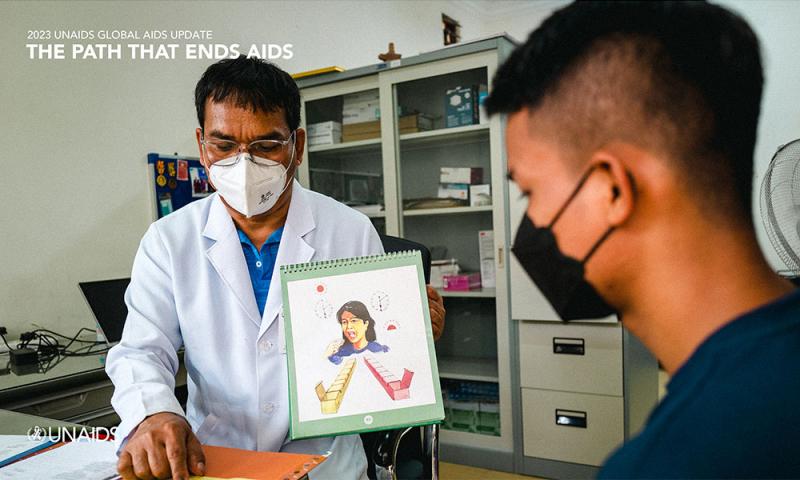LETTER | There is a proven path to end AIDS … are we on it?
LETTER | As countries respond to and recover from Covid-19, a renewed focus to end AIDS couldn’t be more urgent. Here’s the question - how can we do it better, faster and more sustainably?
The recently released UNAIDS Global AIDS Update Report shows that there is a path that ends AIDS and ensures preparedness to address future pandemic challenges, and advance progress across the sustainable development goals.
The data and examples in the global report make it very clear what that path is. It is not a mystery. It is a political and financial choice.
HIV responses succeed when they are anchored in strong political leadership to follow the evidence; tackle the inequalities holding back progress; enable communities and civil society organisations in their vital role in the response; and ensure sufficient and sustainable financing.
Several countries are already on track. Botswana, Eswatini, Rwanda, the United Republic of Tanzania and Zimbabwe have already achieved the 95–95–95 targets.
This means 95 percent of people living with HIV (PLHIV) know their status, 95 percent of PLHIV who knew their status received treatment and 95 percent of PLHIV receiving treatment have viral suppression. At least 16 other countries are close to doing so.
M’sia progressing well
Malaysia has reached 81-68-87, a significant progress we have witnessed over a decade of effort between the government, bilateral and multilateral partners, civil society organisations, communities of PLHIV and key populations and other development partners across multiple sectors and levels.
Leadership from the Health Ministry and concerted efforts from community partners will further pave the way to achieve 95-95-95 targets in the coming years.
Governments can do - and many are already doing - more to end AIDS. Progress has been strongest in the countries and regions that have the most financial investments, such as in eastern and southern Africa.

And a more inclusive approach to legal and policy frameworks is also a key here. To do so, we need to listen to everyone, including marginalised groups, in their own words.
Malaysia is at a significant moment: National ownership and domestic investment in HIV response is exemplary.
Historically, the country has allocated a significant proportion of domestic resources to HIV response. In 2022, US$20.6 million was spent on HIV response and of which 93 percent came from domestic sources.
Furthermore, Malaysia has made an AIDS-free generation a reality and it was the second country in the Asia and the Pacific region to achieve elimination of mother-to-child transmission of HIV and syphilis in 2018.

Since then, the country has maintained its achievements in the elimination of mother-to-child transmission of HIV and syphilis. New HIV infections among children have declined by 94 percent since 2010 and 81 percent of children living with HIV are on treatment in 2022.
These examples of putting people and communities first demonstrate how together we can end AIDS as a public health threat by 2030.
As the report sets out, however, none of this will come automatically. Whilst access to HIV treatment has helped save 20.8 million lives, these life-saving advances are still being denied to millions of people who urgently need them.
Globally, AIDS claimed a life every minute last year. There were 1.3 million new HIV infections, and 9.2 million people are still missing out on treatment, including 43 percent of children living with HIV.
Ongoing social and economic inequalities within countries and between them are exacerbating and prolonging pandemics and amplifying their impact on the poorest and the most vulnerable.
The facts and figures are telling us that we have a monumental task to do. We know the steps that need to be taken, and we need to act now.
Yet, around the world, punitive laws and policies, human rights violations and discrimination continue to greatly increase the risk of HIV transmission and sabotage efforts to control the epidemic among key populations.
Repressive policies a step backward
Repressive policing of sex workers almost doubled their risk of HIV or sexually transmitted infection, and there is compelling evidence linking policing practices with increased risk of acquiring HIV.
And when civil society organisations faced barriers to operating, the prevalence was more than nine times higher than in countries without such obstacles.
The obstacles in the way of progress can’t be navigated just by avoidance. We must overcome them head-on.
The path that ends AIDS requires collaboration - South and North, governments and communities, UN and member states together. And it requires bold leadership.
The route map in the Joint United Nations Programme on HIV/AIDS (UNAIDS) new report shows how success is possible in this decade - if we move together and with urgency.
The Malaysian government has done a tremendous job in HIV prevention.
And we remain walking in a collective fight with them and other partners in the HIV response to end AIDS, not just to be AIDS-free by 2030, but also to sustain the response and build quality healthcare inclusive for everyone now and in the future.
Author is the Joint United Nations Programme on HIV/AIDS (UNAIDS) country director for Cambodia, Lao PDR and Malaysia.
The views expressed here are those of the author/contributor and do not necessarily represent the views of Malaysiakini.
RM12.50 / month
- Unlimited access to award-winning journalism
- Comment and share your opinions on all our articles
- Gift interesting stories to your friends
- Tax deductable
